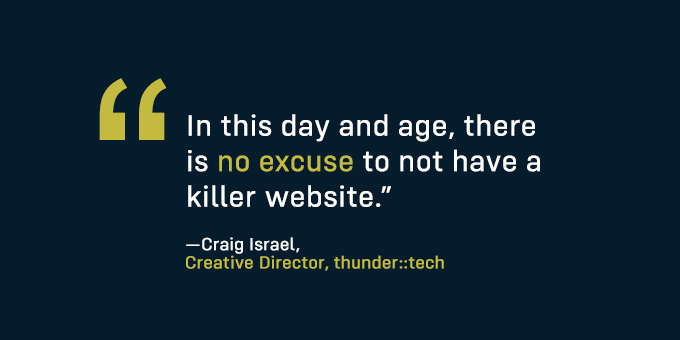
Trying to do more with less is a way of life for many nonprofits. That’s exactly why it’s so important to make the MOST of your marketing efforts. Below, we’ll examine 10 ways you could be dropping the ball on your marketing when it comes to …
- Sharing your stories
- Balancing digital and print
- Repurposing your content
Also, as a Cleveland-based printing company, POV Solution thought it only natural to gain insights from a couple of great marketing minds in our own backyard.
In the following, they’ll do more than help you take a hard look at your marketing. They’ll give helpful ways to improve it!

1. You’re Failing to Use Your Nonprofit Superpower
The tools, technology, and strategies you use to market yourself may continually evolve. But you also have a constant beacon within that sea of change: Your nonprofit’s real-life stories. They’re your number one marketing asset.

“Nonprofits traditionally have really compelling stories, and that’s a huge advantage,” says Elizabeth Krouse, communications manager at Fieldstone Farm Therapeutic Riding Center.
She says successful nonprofit marketing is really about conveying stories that resonate with people’s emotions.
Fieldstone Farm is a veritable feast of poignant stories. Wounded veterans, seniors with memory challenges, children with physical or emotional needs—these are just a few examples of the people who experience the transformative power of therapeutic horse riding.

But even if you lack the emotional one-two combo of kids and ponies, chances are good your stories are still your nonprofit superpower. They encapsulate who you are and what you do to make the world better.
Don’t forget to use them everywhere you can.
2. You’re Telling the Same Stories to Different Audiences
Okay, so you’re swimming in soul-stirring stories. But that doesn’t mean you should share them all willy-nilly. Maximize their power by using them selectively.
You’re trying to reach multiple audiences—volunteers, small donors, big-ticket donors, various kinds of businesses and other organizations.
Krouse says people will be moved to give based on stories that match with what they care about most. And this is especially important with fundraising.
“Don’t just blindly approach a foundation, for example,” cautions Krouse. “Really research the kind of things they give to and what their interests are.” Then reach out by showcasing a specific project or two that your research indicates will really resonate with them, she says.
3. Your Website Stinks
“In this day and age, there is no excuse to not have a killer website,” says Craig Israel, creative director for the integrated marketing agency thunder::tech.

But for a nonprofit in particular, the momentum of your small staff’s day-to-day duties can prevent you from analyzing your website and making sure it’s generating the results you want.
What about all the visitors who came to your lackluster site and weren’t moved to take the next step? Those are missed opportunities for donations, volunteers, and overall support that your nonprofit depends on.
Even though a great website is critical for any operation, Israel says it can be especially important for nonprofits. “You have to have a website that makes people confident that you’re legitimate and aboveboard. Then educate them about your mission and get them involved.”
4. You’re Not Making a Clear and Strong Ask
It’s a problem Israel has seen over his 20 years in marketing: Nonprofits can forget to effectively ask for what they want.

When it comes to your website’s call to action, Israel says to make sure you don’t drown your visitor in extraneous info.
“Make it clear how they can get involved,” he says. “If I care enough to go to your website and poke around, I’m already a little invested. I may just need that nudge.”
Here are a few easy ways to make your request bold and clear:
- Use prominent call-to-action buttons that make it easy for people to follow your request.
- Display timely announcements for events on your homepage that include specific info on what you want people to do.
- For public events, use bold signs or banners at your exhibit that clearly identify this is where people can make a donation, sign up for volunteering, etc.

5. You’re Putting Too Many Eggs in the Digital Basket (and Ignoring Print)
There are lots of compelling reasons why print collateral should remain an indispensable part of your overall marketing strategy.
For example, Israel explains that when you want someone to give you something, people may be more inclined if you give them something first. But he’s not talking about actual gift items, though some nonprofits do that quite effectively.
No, he’s referring to a quality piece of printed material that appears in the mail. “The person is subtly experiencing something you’ve given them. Now, that may not be a lot, but you could argue it’s way harder to ignore that than an email you can delete in a second,” says Israel.
In fact, Israel’s point is borne out by the research on sensory marketing. Studies have shown that the act of touching marketing collateral can have a powerful effect on people’s attitude toward an organization.
Along with the points above, statistics like the following suggest digital’s oversaturation and underscore print’s abiding relevance:
- Stagnant growth. The 2019 M+R Benchmarks Study says that nonprofit online revenue for 2018 increased by just 1%, marking “the first time in 13 years … that we are reporting average revenue growth in the single digits.”
- Discouraging email response rates. When it comes to email fundraising, M+R says that “nonprofits are facing serious challenges.” For example, there has been a reduction in response rates for advocacy emails (1.8%, down by 15%) and fundraising emails (.06%, down by 13%).
- Digital’s dominance not so clear-cut. In a study conducted by Grey Matter Research Consulting, nonprofit donors were asked which method of communication they prefer, email or direct mail. They were almost evenly divided in their responses with 37% favoring direct mail, 35% email, and 28% saying either would be okay.
- Weaker trust in digital. A MarketingSherpa survey found that three of the top five most trusted advertising channels were either print or signage (the other two were TV and radio ads).
- Everyone is not on the internet. The Pew Research Center reports that 1 in 10 adults in the US (+25 million people) doesn’t use the Internet, a number that’s actually held steady for the past four years despite efforts to encourage internet use in underserved regions.

6. You’re Giving Your High-End Print Collateral to Everyone
Even if you’re using plenty of print in your marketing efforts, how much strategy are you putting into it?
For example, Western Reserve Land Conservancy puts out an annual report full of gorgeous full-color photos that highlight their efforts.
They feel this printed piece is worth the investment. But as an environmentally-focused nonprofit, they’re also concerned with post-consumer waste.
So instead of doing away with a printed report, they mail it to a select group of major donors. Meanwhile, others receive a postcard that directs them to the PDF version on their website.
In the end, everyone gets a chance to see it. But by being strategic, this nonprofit saves money and maintains a more environmentally responsible approach to printing.

7. You’re Not Targeting Your Audiences (Which Can Save You Money and Generate Better Results)
Rather than blanket an area with thousands of mailers, Western Reserve Land Conservancy looks for relevant community outreach events with audiences favorable to their mission.
They then set up their exhibits to a more targeted audience of a few hundred. The printed material that these attendees take with them has a better chance of actually creating results.
Here are a couple of additional tips for smarter use of printed items:
- Consider innovatively-designed items like self-mailer brochures. These can be an all-in-one solution that lets you combine a brochure and a return envelope into a single mailable piece.
- Donation envelopes are relatively inexpensive and can be used in all your mailings and events so people always have an easy way to give money.
8. You’re Wasting Money and Time by Doing Print-Related Tasks Internally
How valuable is the time of your staff? Seeking outside support for mailing services and digital printing can play a pivotal role in using your time more cost-effectively.
For example, Western Reserve Land Conservancy uses print vendor support for things like their annual fundraising mailings.
According to the nonprofit, the investment upfront is worth it because they save so much time and money by not having to stuff envelopes in-house.

9. You’re Not Milking Your Earned Media for all it’s Worth
“Earned media” basically means free media or publicity. And who doesn’t love—and deserve—that more than a nonprofit?
If you get exposure through, say, a local TV network or a publication, hey, that’s great! But is your work done? Not even close!
Craig Israel from thunder::tech says nonprofits can be so grateful they were mentioned somewhere that they forget all the ways to reuse that earned media. But that’s a huge mistake!
He says this is your chance to transform that spotlight moment into multiple marketing opportunities:
- Spread the word in your e-newsletter and link to it.
- Push it out to all of your social media channels.
- Establish a prominent place on your homepage where you link to it.
- Make it part of your archived web resources (like on your In the News page).
- If it’s a video, play a compelling excerpt or the full version during your next stakeholder meeting, volunteer dinner, or public gathering.
- Pull a snippet and make it part of your next promotional highlight video or create a five-second pre-roll YouTube video.
- Take a great line from it to use as a block quote in your next fundraising newsletter.
10. You’re Creating Content Just Once and Missing Opportunities to Repurpose
Are you familiar with COPE? It’s short for create once, publish everywhere, and it’s a critical way to maximize the time, money, and effort you spend on creating marketing content.
Israel stresses that nonprofits should be doing all they can to reuse—i.e., “publish everywhere”—the content they create.

If you’ve invested a lot of time and money in high-quality content, you now have a golden opportunity to maximize that investment. That’s really what COPE is all about. Consider these examples:
- Did someone give a presentation at a meeting or conference? Record it and make it available as a resource from your website.
- Slice and dice the video content for reuse in a variety of other venues (see number 9 above).
- Don’t forget the presentation content can be transformed into a variety of written formats.
- How often does your staff speak at events? You can eventually assemble a library of video resources on your website and even establish your own YouTube channel, which is free!
- Did one of your experts write an article? Repurpose it into a blog post, a web page, a one-pager or brochure, a fundraiser letter, or even condense it into a postcard mailer.
You May Already Have More Than Enough to Create the Results You Want
Sure, wishing for bigger staff, more hours in the day, or a heftier budget is understandable. But are those things imperative to improve your marketing efforts?
Start with what you have right in front of you. You have a lot going for you that others don’t—specifically, a mission people can feel passionate about and stories that move them to action.
As we’ve seen above, you can get more from your marketing dollars by seeking ways to spend smarter.
And when you see a marketing opportunity? Don’t forget that behind it could be 10 more opportunities waiting to be seized!
If you’d like assistance with your print collateral efforts, you should know that POV Solution gives you more than convenient online ordering. We provide expert design and technical support. Contact us today!
